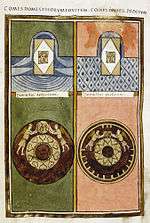Domesticus (Roman Empire)

The origins of the word domesticus can be traced to the late 3rd century of the Late Roman army. It stems from the term “Protectores Domestici”, a guard unit serving as the staff to the Roman Emperor.[1] It is said that they originated from being “comes”, which were companions, or counts in various offices and the emperor, in this case a guard unit.[1] They often held high ranks in various fields, whether it was the servants of a noble house on the civilian side, or a high ranking military position. After serving under the emperor for a certain duration, the Domestici would be able to become leaders themselves and potentially command their own regiment of legionnaires in the military. Relatively, the most important offices were the “Comes Domesticorum” also known as, “Commander of the Protectores Domestici,” and “Comes rei Militaris” or General.[1]
Origin
The domestici rose to prominence during the Crisis of the 3rd Century,[2] the myriad of societal catastrophes nearly led to the collapse of the Roman Empire. The accession of Diocletian and his subsequent reforms ended the continual strife and unstable leadership Ancient Rome had faced during this period. The title of “Domesticus” was developed to advocate for better control over the empire. The domesticus provided defined leadership in the military as officers; oversaw individual households and lands to protect common civilians and servants; and served as palace troops assigned to the emperor himself—all to prevent further crises in the future and transitioning into later periods of the Roman Empire.
Late Roman Empire
The roles of the domestici in the Roman Empire evolved during the late Empire. From 330 AD to 474 AD they were given a variety of functions depending on whatever they were assigned to. Many held positions as Generals and even elevated to become emperors if they gained enough notability. Constantius Chlorus was a Domesticus that after many successful military campaigns became one of the joint Emperors of the Roman empire with Maximian. Many of the notable Domestici of the Roman Empire existed around the time period which the Roman Empire was splitting into its eastern and western halves. Many of Diocletian successors mirrored his successes because they to after many military successes gained a lot of notability and took the throne as emperor from the sitting emperor but many of them didn't have long reigns because how unstable the western Roman Empire was. These emperors were the ones that did realize because of their military experiences that it was not possible to sustain the size of the late Roman Empire leading to them continuing Diocletian’s idea to have it separated into the eastern and western halves. This cycle of instability and military rule in the western Roman Empire continued until its fall in 476, and Zeno the last emperor of the eastern Roman Empire and the First Emperor of the Byzantine Empire where he ruled from August in 476 until his death in April 491.[1]
Byzantine Empire
As the Byzantine Empire was gaining strength economy, new patterns in governing from how things were in the late Roman Empire, and a growing bureaucracy in the early 500’s under the rule of the Byzantine Emperor Anastasius 1 the successor to Zeno the title of Domesticus was evolving and often being used as synonyms of Vicarius and Locoservator. These titles basically translate to ‘vice’ which meant they basically reported to any superior this title wasn’t given to people in charge by the year 504 in the Byzantine Empire.[3] The translation of Domesticus, Vicarious, and Locoservator respectively mean belonging to a house, Vice meaning deputy or substitute for a superior, and subordinate to the count or duke.[3]
Notable Domestici
- Aidoingus
- Ammianus Marcellinus
- Count Aelianus (prior to career as Count)
- Constantius I
- Diocletian
- Jovian
- Magnentius
- Maximinus Daia
- Tarasis, after successfully plotting against the Gothic general Aspar, he was given this title by the emperor Leo. Tarasis later succeeded Leo I as Emperor Zeno.
References
- 1 2 3 4 Syvanne, Ilkka (2015-09-09). Military History of Late Rome 284-361. Pen and Sword. ISBN 9781473871847.
- ↑ "Crisis of the Third Century - Crystalinks". www.crystalinks.com. Retrieved 2017-10-31.
- 1 2 Laiou, Angeliki (1998). Studies on the Internal Diaspora of the Byzantine Empire. Washington D. C.: Dumbarton Oak Research Library and Collection. p. 49.